We started out just like many of you, trying different CMS platforms to build our websites. Before settling on WordPress, our WPBeginner team experimented with everything from Joomla and Drupal to Wix and dozens more.
Through years of building personal sites, client projects, and various side ventures, we’ve gained deep insights into what makes each CMS tick. While we’re confident WordPress is the best choice for most websites, we understand that every project has unique needs.
That’s why we’ve put together this comparison of the best CMS platforms. We’ll help you find the perfect match for your website, whether you’re building a blog, business site, or online store.
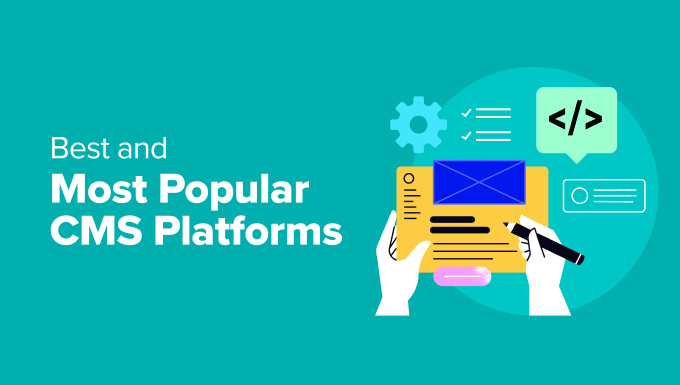
In a hurry? No worries! Take a look at our top picks, so you can quickly choose the best CMS platform for your site.
🥇First choice

Pricing: It’s FREE and open source
Perfect for building a site without technical skills
Easy customization thanks to 12,000+ free themes
Extend your site features with 59,000+ free plugins
Largest supportive community
Needs a domain name and hosting
🥈Second choice

Pricing: Starts at $15/month (Free plan is limited)
Designed for marketers and business owners
“What you see is what you get” (WYSIWYG) editor
Fully integrated marketing hub right out of the box
Very limited marketing tools are available
No separate hosting is needed
How We Test & Review the CMS Platforms
Our editorial team at WPBeginner consists of people with varied expertise, including designers, developers and marketers.
- Hands on experience: We have hands-on experience with different CMS platforms by working for different personal, clients and side projects.
- We regularly work on popular CMS: Our partner brands, like OptinMonster and PushEngage, build tools that are compatible with all the popular CMS, including Joomla and Shopify.
- Test projects: Aside from that, we also set up test projects on different platforms and even publish detailed reviews and comparisons by examining those platforms regularly.
Why Trust WPBeginner?
For over 16 years, WPBeginner has been the world’s largest free unofficial WordPress resource website. Aside from publishing WordPress guides, we occasionally compare other platforms on WPBeginner. To learn more, see our complete editorial process.
Popular CMS Platforms: Frequently Asked Questions
Before we get to the list of the best and most popular CMS platforms, let’s answer some basic, frequently asked questions about them.
What is a CMS Platform?
A CMS platform (content management system platform) is a piece of software that allows you to easily manage content and create a website.
Normally, web pages are written in HTML, JavaScript, and CSS programming languages. If you were to build a website without a CMS platform, then you would need to learn these languages and write a lot of code.
CMS platforms solve this problem by allowing you to make a website without writing code or learning programming.
How much does a CMS platform cost?
CMS platforms charge fees differently. Some platforms are free to use, while others only offer paid plans.
Keep in mind that to build and run a website online – with or without a CMS, you’ll need web hosting (where your website content and files are stored).
- When a CMS platform charges a fee, that means their pricing typically covers the CMS software and web hosting fee to store your website content.
- There are certain platforms that offer free plans. This means that they let you build a site with their CMS and offer free web hosting. Typically, these plans are very limited and restrictive.
- The last type of CMS is open source. This means the CMS software is free to use, but you’ll have to install it on a web hosting server of your choice. This also means you’ll only pay for the hosting fee and use the CMS without restrictions.
How do I choose the best CMS platform for my website?
Below are a few factors you’ll need to consider when choosing a platform.
- Ease of use: Use a CMS that makes it easy for you to create and edit content. This often means having a drag and drop interface, so you can add different elements on your pages.
- Design options: Your CMS software should offer you plenty of website design templates to choose from. It should also allow you to easily customize those web designs to your own requirements
- Data portability: A great CMS platform should have tools for you to easily export your data and move it elsewhere in case you need to switch CMS later.
- Extensions and addons: You should be able to easily extend the features of your site with extensions and addons without having to hire a developer.
- Help and support options: When you need assistance with your CMS, you should be able to find the right experts to troubleshoot your problems and fix them. Choose a CMS that has a big supportive community that can help you solve your website issues.
With these things in mind, let’s take a look at the best CMS platforms to choose from.
1. WordPress.org
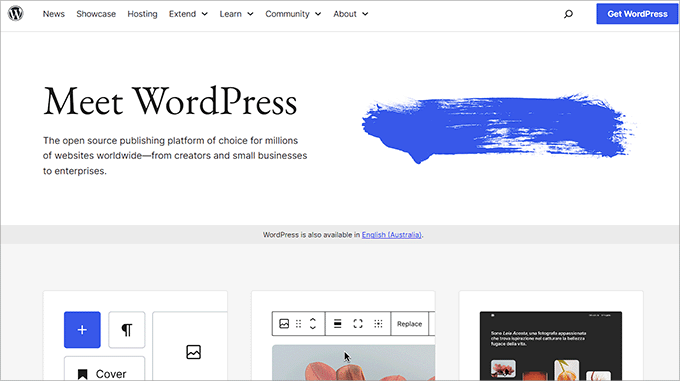
WordPress is our number one choice for the best CMS platform. We built all our websites with WordPress, including WPBeginner, the website you read now. WordPress is the world’s most popular CMS software, and it powers around 43% of all websites on the internet.
Here’s our complete WordPress review.
Keep in mind that WordPress.org is different from WordPress.com. WordPress.org is a free open source CMS, which needs to be installed on your preferred web hosting server to start building your site. On the other hand, WordPress.com lets you start build a blog right away by signing up for a free account.
If you’re not sure about the difference between the two, check out our detailed comparison of WordPress.org and WordPress.com.
Note: When we talk about WordPress on WPBeginner, we normally mean WordPress.org. We specify WordPress.com where appropriate.
Pros of WordPress.org
- WordPress offers you the flexibility and freedom to build any kind of website (online store, auction site, membership site, etc).
- It does not require any technical skills or coding knowledge. The WordPress block editor makes it really easy to create great looking pages on your site.
- Unlike most free CMS, that charges you when you monetize your site, WordPress gives you complete freedom to make money online from your website in any way you want.
- There are thousands of WordPress themes and plugins available, both paid and free. These let you add all sorts of useful extras to your site, like contact forms, photo galleries, social media share buttons, and much more.
- WordPress is really well designed for search engine optimization (SEO). It’s easy to create SEO-friendly URLs, categories, and tags for your posts. You can also choose from plenty of SEO plugins to help you do more.
- There’s a huge and supportive community around WordPress, as it’s an open source CMS. You can join groups like the WPBeginner Engage Facebook group to get help with any problems you run into.
- WordPress offers a lot of extensibility which is what makes it an ideal CMS platform for both beginners and developers alike.
- WordPress lets you download all your content in XML format, making it easy to move to a different system in the future if you choose to do so.
Cons of WordPress.org
- You’ll need to set up your hosting and domain name, and you’ll be responsible for managing things like security and backups.
- Because WordPress offers so many options and so much flexibility, it can sometimes feel a little daunting when you’re getting started. This is why many beginners use drag & drop page builder plugins for WordPress.
Pricing
WordPress itself doesn’t cost anything. However, you’ll need a domain name (around $9 – $15 per year) and a hosting account with a web host that can run WordPress (normally from $7.99/month).
We have a special deal with Bluehost where you can get WordPress hosting for just $1.99/month, which includes a free domain and free SSL certificate.
If you need some help getting your WordPress site started, check out our guide on how to make a website with step-by-step instructions.
2. HubSpot Content Hub
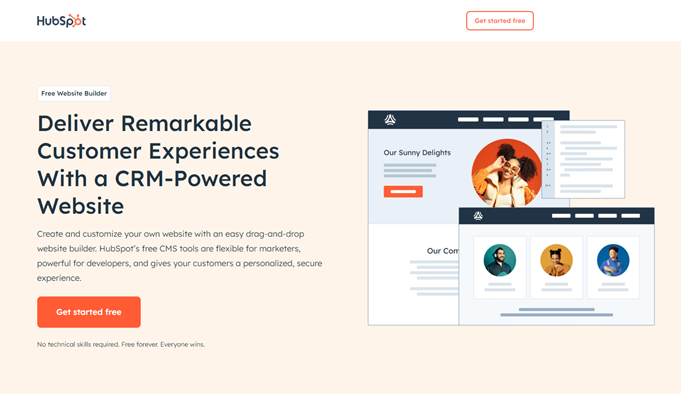
HubSpot Content Hub is a fully integrated content management system that is specifically designed for marketers and business owners.
From our test, we found that Hubspot Content Hub is best for those who want a combined CMS and CRM (Customer Relationship Management) solution. It is built on top of HubSpot’s CRM platform, which includes all sorts of marketing automation, sales, service, and operations tools.
For more details about Hubspot CRM, you can take a look at our Hubspot review.
If you’re NOT fond of their CRM solution, then Hubspot Content Hub may not be an ideal choice.
Pros of HubSpot CMS
- As we tested their CMS solution, our overall impression was that HubSpot Content Hub is easy to use even if you have little to no technical skills.
- We liked their smart content features to personalize your website page to specific visitors or larger segments.
- We also discovered that for developers, there are serverless functions, flexible theme options, and command line tools, so you can make changes and customize assets faster.
- Content Hub comes with built-in security features — including a global CDN and Web Application Firewall, along with a dedicated security team to keep your site safe from DDoS attacks, hackers, and other anomalies.
- HubSpot CMS seamlessly integrates with their email marketing tool and sales CRM, so you can streamline your operational workflows.
Cons of HubSpot CMS
- There is a free version, but it requires you to have HubSpot branding on your site.
- HubSpot CMS isn’t as well-suited for eCommerce websites. You’ll have to integrate it with an external eCommerce solution like WooCommerce or Shopify.
Pricing
Their Starter plan, if you were to pay annually, costs you $15/month and has all the features you need to build a fully-functioning website. The higher tiers are better suited for building more complex web apps with dynamic personalization and internal processes.
A lot of smart business owners use HubSpot’s free marketing tools while using WordPress as the CMS platform to build their website.
3. Joomla

Joomla is another popular free open-source CMS platform that comes with lots of different templates and extensions. It’s free to use, but you’ll need hosting and a domain name. According to our CMS market share report, Joomla powers 1.72% of all websites.
It was first released in 2005, so like WordPress, it’s been going for years. Joomla is packed with features, and many web hosts offer a 1 click installation. When reviewed the platform, we noticed that it’s an ideal CMS platform for developers and experienced website creators. However, it’s not such a good option for beginners because the community support is not as huge as WordPress.
Pros of Joomla
- During our test, one thing that stands out in Joomla is that it offers plenty of options out of the box. It’s a good choice if you’re building something complicated or bespoke.
- Although Joomla is particularly useful for developers, you can still use it even if you don’t want to ever touch a line of code. It’s easy to edit your content.
- Like WordPress, Joomla is open source, and there’s lots of community support available if you get stuck.
- You can use Joomla to run an eCommerce store as there are extensions available for this.
Cons of Joomla
- Even Joomla fans will admit it can be pretty complex for non-techy users. Depending on what you want to do with it, you may well need to hire a developer to help out.
- There aren’t that many options for additional extensions. If you’re used to a CMS like WordPress, which has thousands of available themes and plugins that extend the core functionality, you might be disappointed by Joomla.
- There can be some compatibility issues if you have a lot of different extensions and modules installed.
Pricing
Joomla itself is free, though you’ll need to pay for a domain name and web hosting that supports Joomla. SiteGround is a good option here, as they have specific Joomla hosting plans with lots of handy features.
You may find yourself paying for some extensions to add more functionality to your website. You might even want to budget for getting help from a developer, depending on what you’re trying to achieve.
4. WooCommerce
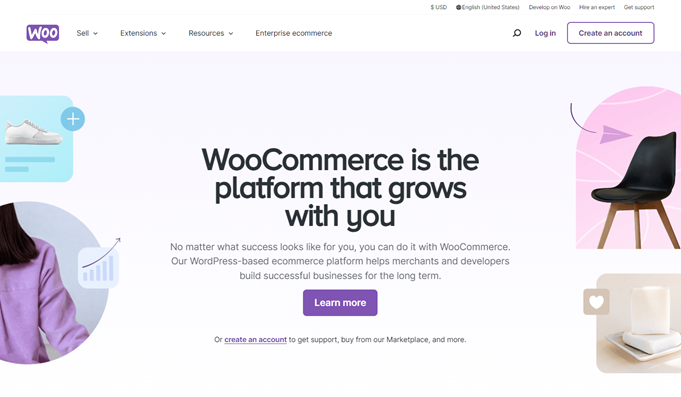
WooCommerce is the most popular eCommerce platform in the world. It’s really flexible and it’s easy to manage.
We thoroughly tested the platform and published our detailed WooCommerce review here.
Unlike most CMS platforms we explained in this post, WooCommerce runs on top of another CMS, WordPress. That means it is a WordPress plugin, not a full-featured CMS.
However, just like other CMS, many hosting providers offer WooCommerce hosting, which enables you to quickly launch an online store.
Pros of WooCommerce
- WooCommerce is available as free software, but you’ll need WooCommerce hosting and a domain name to get started.
- There are lots of WooCommerce themes available, which makes it really easy to get your eCommerce site looking exactly how you want.
- WooCommerce has lots of available extensions (known as WooCommerce plugins) that let you add extra functionality to your site.
- You can sell physical or digital products using WooCommerce. You can even sell affiliate products through affiliate links.
- You can fully manage your inventory through WooCommerce, making it easy to keep track of what you have in stock.
- WooCommerce comes with PayPal and Stripe payments by default. You can also add any other payment gateways through extensions and add-ons.
Cons of WooCommerce
- There are a lot of different options in WooCommerce, which can be a bit daunting when you’re new to setting up a website.
- WooCommerce technically works with any WordPress theme, but you may want to stick with themes made specifically for WooCommerce for extended support.
Pricing
The WooCommerce plugin itself is free, but you may need to pay for extra plugins and extensions for your online store.
You’ll also need to pay for a domain name and a web hosting account. SiteGround and Bluehost are great web hosts to pick as they’ll install WooCommerce and the Storefront Theme on your site for you.
5. Drupal

Drupal is another open-source CMS solution. It’s the CMS behind some major websites, including The Economist’s site and several university sites.
Our opinion is that Drupal could be a good option for developers or for people able to hire a developer. It’s especially good if you’re aiming to build a highly customized site that needs to handle a lot of data.
You can host a Drupal site on SiteGround. They offer free installation and can even help you transfer an existing Drupal site.
Pros of Drupal
- It’s easy to add content on Drupal. The custom content types are flexible and offer plenty of options for content creation.
- There are lots of different modules available that you can add to your site (these work like WordPress plugins).
- Support is available via community support options similar to other popular platforms like Joomla and WordPress.
- User management is easy, with a built-in system where you can create new roles and specify their permissions.
Cons of Drupal
- With Drupal, it can be tricky to figure out how to change the appearance of your site or add extras. It’s definitely not as beginner-friendly as WordPress.
- Most Drupal websites have a heavily customized theme created by a developer, which can be very expensive.
6. Wix

Wix is a popular cloud-based CMS platform, though it has some limitations. We often get readers asking how to switch from Wix to WordPress that’s because every smart business owner knows that WordPress is definitely better than Wix.
In our opinion, Wix could be a good option for those who need a platform that is super easy to start with but don’t mind having a very limited customizable features.
Pros of Wix
- Wix’s drag-and-drop interface makes it really easy to create pages that look just how you want. You can select any part of your page and start editing it.
- There are lots of pre-made templates you can choose from in Wix. These are fully responsive, so they look great on mobiles and computers.
- You can add lots of apps to your site from the Wix App Market. These work like WordPress’s plugins to give your site new features.
Cons of Wix
- Once you’ve chosen a template on Wix, you can’t change to a different one. This could mean that you get stuck with a layout that’s not quite right for your site.
- You can’t run an eCommerce store on Wix unless you upgrade to a paid plan, and even then, you can only accept payments using PayPal or Authorize.net.
- Unlike an open source CMS, Wix doesn’t allow you to easily download your data and export it. You can download your blog posts (though not your images) to move them, but if you have any pages on your site, you’ll need to copy and paste these manually.
- If you’re using the free plan, you’ll have a Wix-branded domain name and ads on your site. The ads make money for Wix, not you.
Pricing
You can use Wix for free if you’re happy with a Wix-branded domain name and ads running on your site. The paid plans offer more flexibility and start from $13 per month (paid upfront annually).
If you want to take online payments, you’ll need to pay $23/month or more (again, upfront annually).
7. BigCommerce
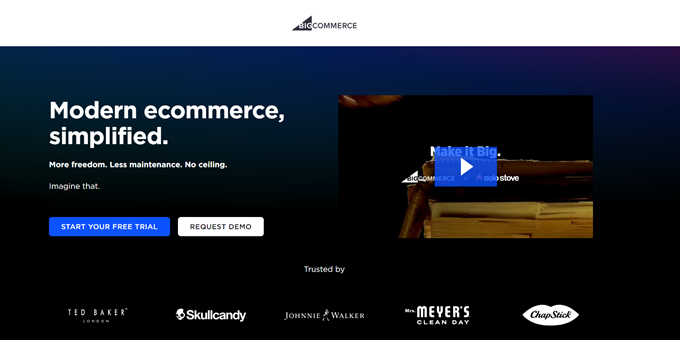
BigCommerce is a fully hosted eCommerce platform, which is sometimes called an all-in-one platform. It’s easy to get started with if you’re a beginner.
BigCommerce hosts your site for you, as well as providing the actual CMS platform itself. It also handles security, backups, and caching for you.
Pros of BigCommerce
- There’s a trial plan, so you can give BigCommerce a go before committing.
- You can use a free domain name from BigCommerce, which will look something like mystore.mybigcommerce.com, or you can pay for a custom domain name.
- There are lots of different ways you can take payments through BigCommerce. Customers can use digital wallets like PayPal, Apple Pay, and Amazon Pay, or they can pay by credit or debit card.
- BigCommerce has support options that you can access straight from your dashboard, 24/7. These include live chat, email, phone support, community support, and more.
- You can use BigCommerce with WordPress if you want to, which can give you the best of both CMS platforms.
Cons of BigCommerce
- BigCommerce doesn’t give you as much control over your store as WooCommerce. There are limited themes and integrations that may hold you back from using a third-party service to grow your business.
- Once your sales reach a certain threshold per year, you’ll be automatically moved up to the next level of the pricing plan. This could be difficult for you if you have a lot of expenses.
Pricing
You need to pay a monthly subscription to use BigCommerce, which means it’s not so cost-effective as some other solutions. With all the plans, you can save a bit of money by paying upfront annually instead of paying monthly.
The cheapest pricing plan, Standard, is $29/month, for up to $50k/year sales. The priciest is the Pro plan for $299/month, which will cover you up to $400k in sales. You’ll need to get a custom Enterprise plan after this.
8. Shopify

Shopify is another all-in-one hosted CMS platform for selling eCommerce goods. You won’t need to buy hosting, install any software, or manage things like updates and backups.
We set up a test eCommerce site on Shopify, and we really liked their intuitive drag-and-drop interface. It supports in-store sales, which is great if you have a physical store as well as an online one.
Pros of Shopify
- You can accept credit and debit cards through Shopify’s integrated payment solution, Shopify Payments. PayPal is also included as one of Shopify’s default payment providers.
- There are lots of extensions and themes available for Shopify. You can buy third-party Shopify apps that let you add all sorts of features to your online store.
- You don’t need to upgrade if you make over a certain dollar amount in sales, like you do with BigCommerce.
- In our opinion, the biggest advantage of Shopify is its 24/7 support through live chat, email, phone, and even Twitter. There’s also lots of documentation available (including written how-to guides and video tutorials), plus online forums.
Cons of Shopify
- Your costs can end up quite high, especially if you want to add lots of third-party apps to your store.
- You may find that you want to add functionality that simply isn’t available: Shopify’s apps are more limited than things like WordPress’s plugins.
Pricing
Shopify’s pricing plans are similar to BigCommerce’s options. There’s one major difference, though. Shopify doesn’t make you move up to the next plan based on a certain dollar figure in sales.
The cheapest plan is $39/month. The most expensive is $399/month and includes more features. You get a discount for paying for a year upfront.
9. WordPress.com
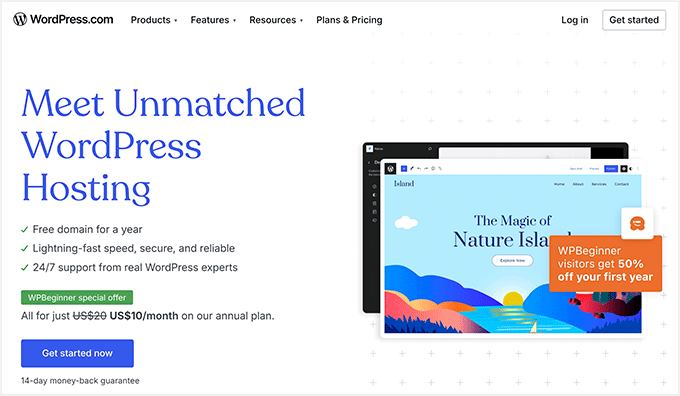
WordPress.com is the commercial, hosted version of WordPress. It’s different from WordPress.org.
WordPress.com makes it easy to sign up for a free WordPress site by creating an account. On the other hand, WordPress.org gives you complete freedom to set up a site the way you want and OWN the site yourself.
If you’re not sure about the difference between WordPress.com and WordPress.org, you can find out more here.
With WordPress.com, you get an all-in-one CMS platform that’s hosted for you. You can purchase a domain name or use a free subdomain with WordPress.com branding.
Note: WPBeginner uses WordPress.org and recommends it to all our readers
Pros of WordPress.com
- WordPress.com is easy to get started with. You can add and edit content easily, and beginners tend to find it a straightforward CMS to use.
- You can create a site with WordPress.com completely free of charge. You’ll probably want to pay for at least the cheapest plan, though, so you can use your own domain name.
- There are different themes (designs) available for your WordPress.com site. You can easily switch between these in your WordPress.com dashboard.
- As your site grows in size and popularity, you can upgrade to a new plan. There are many options, including a plan with eCommerce features.
- WordPress.com has built-in analytics, which means you can see statistics about how many people are visiting your site in your dashboard. This does mean you can’t use Google Analytics, though, unless you’re on a Business Plan.
- It’s quite straightforward to switch from WordPress.com to WordPress.org in the future, if you decide to change to a more powerful and flexible CMS.
Cons of WordPress.com
- WordPress.com has limited monetization options even with their business plan.
- You can’t add a custom domain name unless you pay for at least the cheapest paid plan.
- While there are plugins you can use for your WordPress.com site, there aren’t nearly as many available as there are for WordPress.org.
- You don’t have full control over your site that you’d have with WordPress.org.
Pricing
There is a free WordPress.com plan available, but if you’d like your own domain name (and you want to avoid WordPress putting ads on your website), you need to choose one of their paid plans.
The cheapest is $48/year ($4/month), or you could move up to other plans, including the eCommerce plan for online stores for $270/year ($22.50/month) using our coupon code WPB50. Beyond this, there are WordPress VIP options offering additional features.
10. Ghost

Ghost is a CMS platform specifically designed for bloggers. You’ll often hear it described as a “headless CMS,” which might sound quite odd. This just means that the CMS platform doesn’t force content to be delivered in a specific way.
So, the content or data you produce could be shown on a website, but it could also be sent to a mobile app or something else entirely. If you’re not a developer, though, or you just want to use Ghost for blogging, you don’t need to worry about this.
Pros of Ghost
- You can use Markdown when you’re writing in the Ghost editor. Markdown is a way of formatting text where you add special characters around words to make them bold, italic, and so on.
- Ghost has a content editor that uses cards. These work a bit like WordPress’s blocks in the block editor.
- There’s great support for SEO (search engine optimization) built into Ghost. You don’t need to add any plugins to deliver this.
- Ghost is well set up for charging for content, so if you want to run an online magazine or publication that people pay for, you can do this easily.
Cons of Ghost
- Ghost doesn’t offer the same amount of power and flexibility as WordPress.
- Although Ghost started off as a CMS platform designed just for blogging, some users feel it’s become overly complicated as it now offers things like paid subscriptions for your site’s readers.
Pricing
The Ghost software itself is free, but you’ll need to pay for a domain name and web hosting. Unlike bigger CMS platforms, Ghost isn’t supported by all that many web hosts.
You can get Ghost hosting from Ghost(Pro). The basic plan is $9/month, but you’ll need to upgrade if you want extra staff users or subscribers, potentially paying as much as $199/month.
11. Magento

Magento is a powerful open-source eCommerce platform from the huge software company Adobe. There’s a free version you can download and install on your own web hosting account, called Magento Open Source.
If you want to use this, then InMotion Hosting’s Magento hosting would be the easiest way to get started.
If you prefer, then you can pay for Magento Commerce. This comes with full support, and is hosted for you, but it’s very expensive.
Pros of Magento
- Magento is highly customizable, with lots of third-party extensions available that you can use to add extra features.
- With Magento, you can handle lots of products and customers. It lets your business grow easily, without your site slowing down. (You’ll likely need to upgrade your hosting plan, though.)
- There are some really big-name brands using Magento, including Nike, Ford, and Coca-Cola.
- You can connect different payment gateways to Magento. It also comes with certain options, like PayPal, cash on delivery, and bank transfer, already built in.
Cons of Magento
- If you’re just starting out in eCommerce, Magento might seem overwhelming.
- It can be tricky to find good developers for Magento projects, and it can be very expensive to hire them.
- The support available can vary, particularly if you’re using Magento Open Source and relying on online forums for help.
Pricing
Magento Commerce isn’t cheap. In fact, it’s so pricy that the Magento website doesn’t even tell you what it costs.
Prices start at around $22,000/year, which puts it outside the budget of many new businesses. If you want a powerful eCommerce CMS platform for an established business, though, it could be an option to consider.
However, many larger stores are migrating to either WooCommerce, Shopify, or BigCommerce.
12. Textpattern
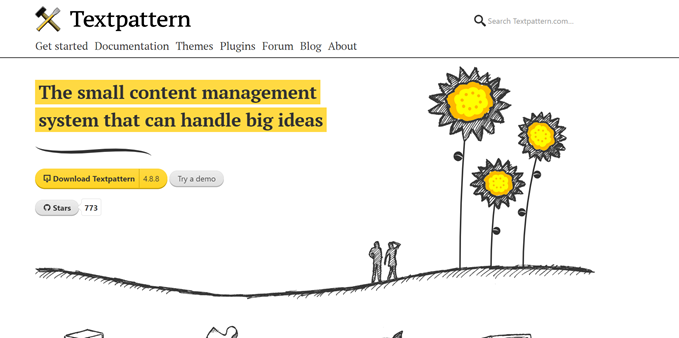
Textpattern is a simple, straightforward CMS platform that’s been available since 2003. It’s open source and has plenty of documentation to help you get started.
Pros of Textpattern
- There are lots of Textpattern modifications, plugins, and templates (designs) available completely for free.
- Textpattern has a flexible approach to how you structure your content. You can use “sections” and “categories” to organize it, and readers can subscribe to specific RSS feeds for different parts of your site.
Cons of Textpattern
- There’s no 1-click installation process for Textpattern with any of the major web hosts. It’s not too tricky to install, but you will have to be comfortable with creating a database on your web host and using FTP to upload the software.
- Textpattern isn’t particularly well known, and it’s much less popular than other CMS platforms like WordPress. You might find it hard to hire authors or developers who are familiar with it.
Pricing
Textpattern itself is completely free. You’ll need to have a domain name and web hosting account in order to use it to build a website.
13. Blogger

Blogger has been around since 1999. As you can tell from the name, it’s a CMS platform that’s specifically geared toward blogging. It’s a free service provided by Google.
Blogs on Blogger normally have blogspot in the domain, though it’s possible to use your own domain name instead.
We’ve got an article looking at WordPress vs Blogger and a guide on how to switch from Blogger to WordPress.
In our opinion, Blogger is the best bet if you want to monetize a blog without having to pay a cent in hosting fees. Unlike Blogger, most free platforms don’t allow you to monetize your website in any way.
Pros of Blogger
- Blogger is easy to get started with. You can set up a blog in minutes, and it’s well designed for writing and publishing posts.
- There are a number of gadgets that you can add to your blog for free so that you can include things like a contact form and even ads on your blog.
- Your blog is hosted by Google. You don’t need to install anything, update anything, or pay for hosting.
- Blogger offers a generous amount of space. There’s no limit on how many posts you can have per blog, and you can have up to 20 static pages. Your images are stored in Google Drive, so they’ll count towards your 15GB limit there.
Cons of Blogger
- If you want to run a website that isn’t a blog, Blogger may not be the right fit. It doesn’t have any eCommerce features, for instance.
- While all the themes available are free, they’re pretty basic. You can modify them a bit, but you can’t create your own themes. If you want something more specialized, you’d need to hire a designer.
- While you can export your posts if you want to switch from Blogger to WordPress, you’ll need to copy your pages over manually.
Pricing
Blogger is completely free, and you won’t be charged anything unless you choose to buy a custom domain name.
If you do buy a domain name, it’s best to get it from a domain registrar, not from Blogger itself. That way, you can more easily move your site away from Blogger in the future.
14. Bitrix24
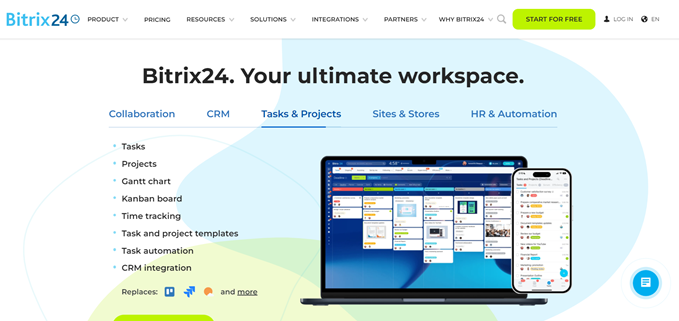
Bitrix24 is a business tool that offers a CMS platform alongside other features like the ability to manage your tasks, projects, communications, and customer relationships.
It’s free at the basic level (which offers up to 5GB of online storage and 12 user accounts) and offers an all-in-one solution for small businesses. If you want a CRM (Customer Relationship Management) tool, it could be a good choice.
Pros of Bitrix24
- The basic level of Bitrix24 is free, meaning you can try it out without committing to anything.
- There are a huge number of features included with Bitrix24, giving you everything you need to manage a small to medium-sized company.
- The website builder has a drag-and-drop interface that includes landing pages and even eCommerce stores.
- Your website hosting is free (if you’re on the free plan).
Cons of Bitrix 24
- Bitrix24 is really geared up for use as a CRM, so if you’ve already got a CRM you’re happy with or you don’t want that functionality, it’s a rather complicated way to get a CMS platform.
- As there are so many features, you may find the Bitrix24 interface confusing or tricky to navigate.
Pricing
The Basic plan costs $43/month, and the Professional plan costs $175/month, with a range of options in between. You get a discount if you pay for the year upfront.
You can also opt to purchase the software to use within your organization (instead of paying a monthly fee and using it online). This costs from $1,490.
15. TYPO3
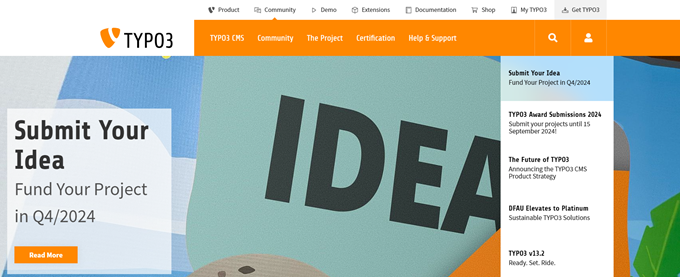
TYPO3 is a free, open-source CMS platform that has been around even longer than Blogger. It was originally released in 1998. It’s an enterprise CMS, which means it’s useful for intranet sites (internal company sites) as well as websites.
There are a number of extensions available for TYPO3 that offer extra functionality, too.
Pros of TYPO3
- TYPO3 can handle really large websites, including ones that have multiple websites in different languages. It’s a good option for large international companies.
- Because it’s open-source, TYPO3 can be extended however you want, if you’re willing to hire a developer to work for you.
- You can easily modify the access rights of different individuals and groups who work on your site.
- There are over 6,000 extensions and applications that you can add to your TYPO3 site to include new features.
Cons of TYPO3
- There aren’t all that many themes available, so you’ll likely have to hire someone to create one for you.
- You’ll need a pretty high degree of technical expertise to get TYPO3 up and running and to maintain it.
Bonus: PrestaShop
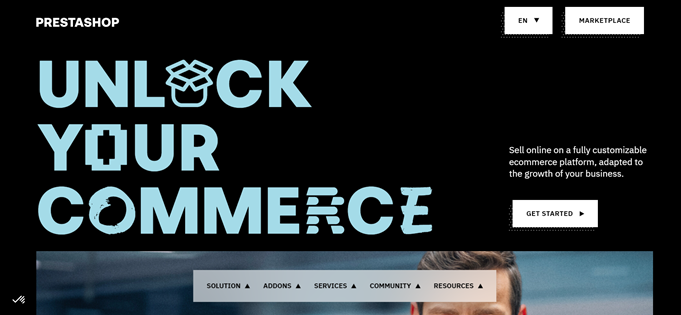
PrestaShop is an open-source eCommerce CMS platform. You host it yourself, so you can install it on any web host that supports it. We recommend using SiteGround’s PrestaShop hosting.
Pros of PrestaShop
- There’s a large PrestaShop community. This includes an official forum where tips and tutorials are shared, plus lots of other groups.
- You won’t have to pay extra as your shop grows (unless you need to upgrade your hosting plan).
- There are loads of PrestaShop modules, so you can add new features easily.
- It doesn’t cost much to get started with PrestaShop, especially if you’re on a cheap shared hosting plan.
Cons of PrestaShop
- PrestaShop can have quite a steep learning curve to begin with.
- There are plenty of themes (designs) available from PrestaShop, but a lot of these aren’t very good. You may have to spend a long time looking through them to find something that’ll work for your online store.
Pricing
PrestaShop is free, though you’ll need to pay for your web hosting and a domain name. The modules and themes available through the PrestaShop Addons Marketplace could add up a lot, though. Most start from $59.99.
Disclaimer: There are many other popular CMS solutions on the market, like Squarespace, Contentful, Webflow, and others. However, we decided not to include them in this list to avoid causing choice paralysis.
Which is the Best CMS Platform?
We believe that WordPress.org is the best CMS platform and website builder in the world. Over 43% of all websites on the internet are powered by WordPress, and there’s a good reason for that.
WordPress has everything you want in a perfect CMS platform. It’s easy to get started, and many WordPress web hosting companies offer a 1 click install process. You can extend the functionality in almost any way you can think of using plugins (which are like apps for WordPress).
On WordPress, you could run an eCommerce store, an online forum, a LMS (learning management system), a membership site, an auction site, a marketplace, and almost anything else you can think of.
There are no limits on what you can do with WordPress, and if you find that you need more space for your site as it grows, you can easily upgrade your hosting to a managed WordPress hosting company.
To get started with WordPress, we recommend using Bluehost or SiteGround for web hosting as they’re officially recommended by WordPress.
Choosing the Best CMS for Your Site
In case there’s still more you want to know about CMSs, we’ve put together this list of frequently asked questions.
Which CMS platform is best for eCommerce?
The best eCommerce CMS platform is WordPress with WooCommerce. While other eCommerce platforms are good too, we think WooCommerce is the best one out there for most online store owners.
You might want to take a look at our comparisons of Shopify vs WooCommerce and BigCommerce vs WooCommerce for an in-depth look at the pros and cons of those platforms.
Which CMS platform is best to build a small business website?
WordPress makes it super easy to build a small business website. It has a very wide range of themes (designs) to choose from and enables you to use all the tools you’ll need to grow your business.
Can I use a CMS platform without a domain name or hosting?
All websites need hosting. Sometimes this is provided by the company that has created the platform (like with Blogger), and sometimes it’s something you buy from an independent web host (like when using WordPress).
If you choose a free platform like Blogger or WordPress.com, you can use their free subdomain to start your blog, such as yourname.blogspot.com. This doesn’t look very professional, though, so you’ll almost certainly want to register a domain name at some point.
Do I need a CMS to start a blog?
Yes, a blogging platform is a type of CMS that allows you to easily publish content. There are lots of different blogging platforms available. Our article on the best blogging platforms compares a number of both free and paid options.
Which is the best CMS software for advanced users?
Because WordPress is an open-source software, it is often the platform of choice for advanced users and web developers.
While WordPress is very user-friendly for beginners, it also has a robust API that developers can use for advanced customization.
WordPress is written in PHP backend, but the front-end is customizable, so you can use it with headless JavaScript platforms.
It can be optimized to offer enterprise-level scalability, multilingual functionality, and basically anything else that you need to build any type of website.
We hope this article helped you learn more about the best CMS platforms. You may also want to take a look at our step by step guide to creating a WordPress website for help on getting started with WordPress, or see our expert picks of the best business phone services.
If you liked this article, then please subscribe to our YouTube Channel for WordPress video tutorials. You can also find us on Twitter and Facebook.






George
For me the best Wordpress alternative is Vvveb CMS the same simplicity and ease of use minus the bloat and it has all the basics included like page builder, SEO etc without installing 3rd party plugins.
Jiří Vaněk
I’ve tried a lot of content management systems in my life, and I probably can’t say that any of them are outright bad or great. Each system had something going for it and also something that bothered me. My first blogs were built on Joomla and WordPress. That was 15 years ago, and back then, Joomla seemed incredibly robust and sophisticated compared to WordPress. But eventually, Joomla fell behind, and WordPress took over. The same goes for Drupal—years ago, it was fantastic for me. The longer I’ve used WordPress, the more I’ve grown to love it. Ten years ago, though, it was unthinkable to have an e-shop on WordPress; Joomla was the best for that. Now, WooCommerce is dominating all possible solutions. I enjoyed reading this article and learning your perspective on the pros and cons of the content management systems in this list. It gives a fresh view and perspective on today’s available solutions.
Oyatogun Oluwaseun Samuel
Before embracing word press i have been an avid user of joomla and I must tell that Joomla is a very versatile CMS platform and very secured if well maintained. However, it cannot match WordPress in term of community support that is available of which Wp Beginner is part of. I am the kind of person that like to know the inner working of things i deal with so I can understand it deeply, to this I find Joomla documentation not easy to understand and they keep changing the names of core classes and methods that powers the inners working joomla modules and component. Whit wordpress the documentation is there very easy to access and there are tons of communities that are enthusiatic about progress and support of their member, these together with easy of use are what attracted me to wordpress and I must say WpBeginner put me on solid foundation with which I built everything I know about wordpress today. I must say thank to you.
This list is very detail and there are many CMS here that I have not heard of and yet these are popular CMS. Kudos to the team at WpBeginner that put this togther.
Jiří Vaněk
I feel the same way. I grew up with Joomla, and I used to do all my ecommerce projects on that platform. I still remember trying to build my first store on VirtueMart. To be fair, VirtueMart was once a solution with very little competition and was truly great. But then WooCommerce came along and changed the game. You’re absolutely right about the community. When I recently looked for a solution for an old site built on Joomla, it was really difficult to find anything. The community isn’t that large, and the documentation feels clunky. With WordPress, I usually find a solution within minutes, or there’s always someone more experienced who can help. Simply put, building websites is much easier for me with WordPress, thanks to the huge user base and the wealth of experience those people have.
Dennis Muthomi
Nice article! I especially liked the comparison between WordPress.org and WordPress.com. As a small business owner I started with .com but quickly realized its limitations. Switching to .org gave me so much more control and flexibility. One tip I’d add: when choosing a host for .org look for ones that offer excellent support and staging environments. That will save you so much time and headaches as your site grows.
Samuel
For me, I have never even for once use the .com as I like the flexibility that .org offered. Regarding staging, I have a self hosted server in Laragon that allow me to sync between live and testing sites. It is really a good tool that streamline works for me. What hosting company are you using that offer staging environments?
Aira Fujiyuki
Ghost is very bad foe self hosting! Their documentations are always deprecated.
Moinuddin Waheed
Valuable insights regarding list of content management systems.
I have tried many of the mentioned platforms and have finally settled with the first one i.e wordpress.org
I can’t make enough arguments in favour of this cms as it gives you the flexibility to test many in one.
one can get the best of all good functionality the each platform has on WordPress itself.
Kelash
Thanks for this valuable information about popular CMS platforms used these days.
I have worked with WordPress.org and Wix at deep stage. Yes, Wix is limited when it comes to proper website development as CMS, you can’t export files or even you can’t change their custom blind pages such as checkout, cart page etc. If you need them customized then you would go for creating your own pages from scratch with Velo APIs.
Sarmad Ali
This is amazing! a detailed comparison it makes it so easy to choose the best CMS according to our needs. Thanks for sharing.
WPBeginner Support
Glad you found our list helpful
Admin
Sam
I think that Joomla did not get what it deserves in this article
Anyway, good information about CMS platforms here!
Escale Solutions
Very informative article! Thanks for sharing such a great list of CMS.
WPBeginner Support
You’re welcome, glad our guide was helpful
Admin
Balkrishna Patil
Insightful… Very nice article.
WPBeginner Support
Thank you, glad you liked our article
Admin
Angga
Thank you for your CMS list. There are very useful because you invlude pros and cons.
This article help me to chose who the best cms. After all, WordPres the best one!
WPBeginner Support
Glad our article was helpful
Admin
Affiniq
Amazing List Thank you For Explaining In Depth.
WPBeginner Support
You’re welcome, glad you like our list
Admin